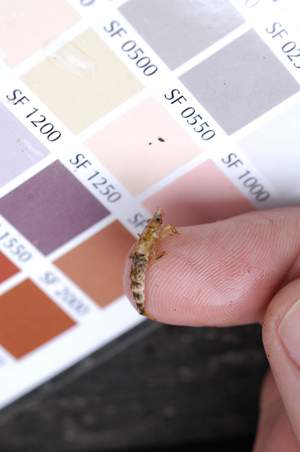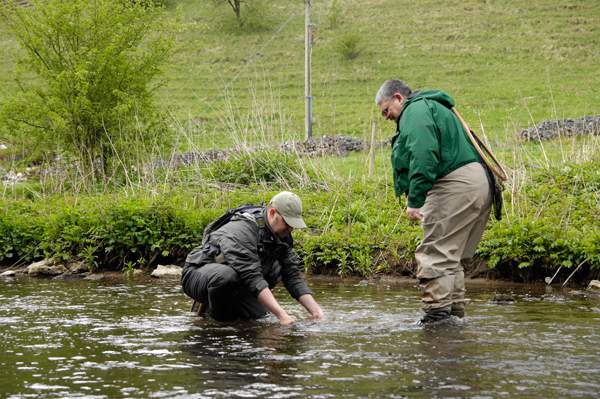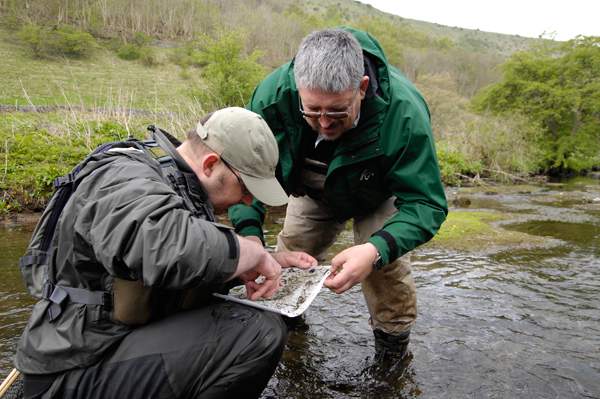Tying by Numbers and Catching More Trout
At the beginning of last year’s trout season, a friend invited me on a fishing trip and assured me that I would need plenty of Large Dark Olive trout fly imitations in my box. I set about tying the necessary flies with bodies of dark olive dubbing. However, when he turned up at my house the LDOs I had tied were a totally different colour from his. My expectation of the body colour was nowhere near his Large Dark Olive dry flies.
I joked recounting a story from the early days of my marriage. Twenty five years ago my wife announced that she would like a pink bathroom so I decided to surprise her. I redecorated and did not let her in for 2 days, forcing her to clean her teeth and wash in the kitchen. When I eventually let her in she got a surprise all right! And I got a load of grief! I’d bought ‘pink’ paint but managed to get a colour which was completely the wrong shade, and nowhere near what she was expecting.
So now looking at the Dulux colour charts we see in hardware stores where colours are defined to a set of colour chips life is much easier. Joking with my fellow angler I said he needed a Dulux colour chart for fly fishing, and this set our brains into overdrive!
Back as a hobby fisherman 10 years ago I’d have great fun going to the river and catching trout and grayling after work or at the weekend. Sometimes I’d have 2 or 3, occasionally as many as 10 fish. They were simple days when fishing was simply a hobby, but now it is becoming more of a science to me. By adopting a scientific approach, I have been able to increase my catches dramatically, and nowadays a daily tally of 20-30 fish is more the norm. Watching fish as they approach my flies just like they approach a natural fly on the surface or invertebrate under water has become a complete delight. Adopting a scientific approach has radically changed by fly tying and fly fishing AND improved catches.
So what exactly was this scientific approach?
Let us start at the beginning. In an experiment I purchased olive fly dubbing from 10 different manufacturers around the UK, and guess what? I ended up with 10 different shades of olive! How can they all be olive?
Even worse, different fly tying furs and feathers will take the same dyes differently, and so the ‘olive’ I originally planned often ends up looking totally different. I then ran a second experiment with a professional fly tyer where I caught a fly and recorded the pantone colour (*1). I then asked him to go home and to match the colour as closely as possible. The results were intriguing, by the time he had gone through his boxes of dubbing the colour he remembered was totally different to the original colour of the fly, even though he had virtually an exact colour match in his dubbing. Seeing so many colours in his dubbing box had convinced his brain that he was on the correct colour.
Matching the hatch precisely with Semperfli colour charts
 So when a fellow angler says that he was catching on flies which were dark olive in colour, we interpret that with our version of ‘dark olive’. I quickly realised that colour names are far too “interpretive”, and so when I met the team behind Semperfli I got very excited. They were talking my language and working with their own colour charts, had defined an entirely new colour system. They said that their colour system would also match their materials exactly. It fitted in perfectly with my thinking and scientific approach. I could now, genuinely, tie by numbers! I would not talk of olive as a colour but ‘olive’ would become a range of colours just like a Dulux colour chart. I would be able to specify the colour of natural invertebrates exactly and when I got home to tie the flies, I could now match that colour precisely.
So when a fellow angler says that he was catching on flies which were dark olive in colour, we interpret that with our version of ‘dark olive’. I quickly realised that colour names are far too “interpretive”, and so when I met the team behind Semperfli I got very excited. They were talking my language and working with their own colour charts, had defined an entirely new colour system. They said that their colour system would also match their materials exactly. It fitted in perfectly with my thinking and scientific approach. I could now, genuinely, tie by numbers! I would not talk of olive as a colour but ‘olive’ would become a range of colours just like a Dulux colour chart. I would be able to specify the colour of natural invertebrates exactly and when I got home to tie the flies, I could now match that colour precisely.
This was exciting stuff! At 50 years old I am still getting that incredible adrenaline rush when I go to the river as I did when I was a child. But now there was an additional element to the excitement.
I set myself and John Pearson of Fish On Productions a challenge in which we would sample natural invertebrates from a river, obtain an exact colour match for them and then simply copy them, tying solely by numbers. Could we - using only the Semperfli materials (Semperfli dubbing system, Semperfli Straggle String, Semperfli Nano silk), along with natural CDC feathers and tungsten beads - match the local invertebrates exactly by colour, and tie copies at the river bank which would then improve our catches on the same day?
The venue was the Cressbrook & Litton Flyfishers Club day ticket water at Monsal Dale, which has a good head cracking brownies and wild rainbows. These are wily fish, used to seeing natural invertebrates and a great many artificial flies. We would definitely have to be more precise with colour and style of fly to catch fish.
Kick sampling to check insects at River Wye

John Pearson & Andy Kitchener kick sampling to check insects at River Wye
Arriving at the water a quick kick sample produced a staggering array of inverts. We found various species of olive (Baetis) nymphs, mayfly nymphs, shrimps, rhyacophila, cased caddis and midges. Twice we repeated the kick sampling in different parts of the river to ensure a good collection of invertebrates. We then started our colour matching exercise. The rhyacophila were matched to SF7250 while most of the baetis were matched to SF5250 and SF6650. Simple bead head pheasant tail variants with Semperfli Straggle String at the thorax were tied to match the colours we found on the olive nymphs.

Checking contents of net after kick sampling
We caught olive duns flying in the air and matched these to SF6450 and SF0400. No fancy dry flies were tied, just simple basic patterns with dubbing matching precisely the colours and 2 natural CDC feathers as wings - spending an hour or so making sure we had a good stock of flies for the day.
And what a day it turned out to be! Monsal Dale fished its heart out for us producing a succession of cracking brownies and rainbows. We caught on baetis nymphs and dry olive patterns all tied with exact colour matches to the natural flies. What is even better is that on the next visit at this time of year we can now simply tie by numbers, SF6650, SF5250, SF7250, SF6450 and SF0400. Any new materials launched by any other fly tying companies can be colour checked against the Semperfli colour charts before purchasing or using them in conjunction with the Semperfli system.
Now when we go to the river we can match invert colours exactly using the Semperfli colour charts. Just like a Dulux colour chart the flies we tie will always match the colour of the naturals. In an ideal world as fishermen we could start pooling the colours of flies and invertebrates world-wide with the Internet and generate exact colour matches so that we know in advance what colour flies are required at different times of year, all over the globe. Maybe that will come later?
----------------------------------------------------------------------------------
*1 The Pantone Colour Matching System is largely a standardised colour reproduction system. By standardizing the colours, different manufacturers in different locations can all refer to the Pantone system to make sure colours match without direct contact with one another.
Check The River Wye Photo Gallery with Semperfli in use
The complete range of Semperfli fly tying materials is available from www.semperfli.net and our fly tying materials shop



















